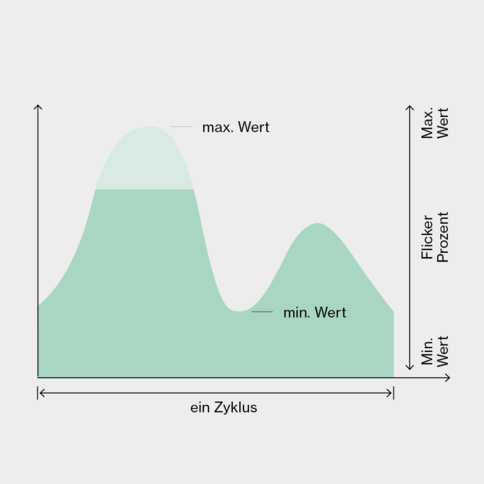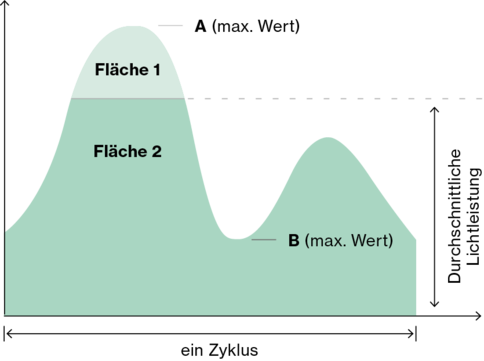Flicker, stroboscopic effect, and temporal light modulation
Temporal Light Artefacts - TLA
In the following text, the two old flicker evaluation methods and the new measurement methods are presented. Preliminary remark: Terms such as "flicker-free" and "camera-suitable" are not standardised terms. Therefore, an objective evaluation of the subject of flicker will be attempted. Temporal light modulation is an irritation for the human eye and is therefore always perceived as disturbing. The eye has adapted over millions of years to a gradual increase and decrease in light intensity as experienced in nature, so that even the slow flickering of a candle can be unsettling.
In addition to the fast-moving rod, there is another assessment method using a mobile phone camera. If streaks are visible on the display when filming into the light source, then the luminous flux is fluctuating. However, this effect depends on the camera’s electronics and is therefore unreliable.
Light modulation can also occur with electric light sources. An incandescent lamp is operated with alternating current at our power grid’s 50 Hz. The current flows through the tungsten filament at twice the frequency, i.e. 100 times per second. This results in glowing and cooling. The luminous flux output consequently fluctuates. However, since the filament is very inert and cools down only very slowly, this light modulation is not perceived as disturbing.
In LED technology, a converter is responsible for smoothing the alternating current. Depending on the quality, the signal is smoothed well or badly by the converter. An LED reacts very quickly, so that flickering is quickly noticeable. Minimal fluctuations in luminous flux are called ripple, and usually do not lead to any impairment.
CCR vs. PWM Dimming
If LED luminaires are dimmed by pulse width modulation (PWM), the LED briefly switches off. This absolute drop in luminous flux is perceived as particularly disturbing and can lead to headaches, migraines, and even epileptic seizures. Therefore, any type of dimmer with PWM should not be used. At a frequency > 2000Hz, however, no more impairment could be shown.
Flicker percentage
Flicker percentage or modulation depth describes the drop in luminous flux to the highest value. No flicker at 0%, the worst value is 100%.
Flicker % = 100 (Max - Min) / (Max + Min) = 100 (A - B) / (A + B)
Example: The luminous flux of an incandescent lamp drops from 100 to 85.
Flicker % = 100 x (100 - 85) / (100 + 85) = 8.1%.
With a PWM-dimmed LED, the flicker percentage is up to 100% (very bad). LEDs dimmed by current reduction have almost no flicker. Disadvantage of flicker %: Neither the shape of the modulation curve nor the frequency are considered. There is no exact safety limit.
The flicker % value is only given accurately in the range of 10 to 165 Hz by commercially available "handheld" measuring devices. This simple measurement allows a good initial assessment in most cases. To measure higher frequencies, expensive measuring equipment is needed.
The graph shows the IEEE recommended limits for modulating the current of high brightness LEDs to eliminate viewer health risks. The grey area represents the recommended modulation depths. In the low-frequency range up to ~ 90 Hz, even low light modulation is disturbing. The disturbing influence of light modulation decreases up to a frequency of ~ 2000 Hz.
There is, for example, no negative influence if the flicker is <8% at 100 Hz. Example: At 50 Hz the modulation depth should be <1%, at 100 Hz <8% in order to avoid disturbing temporal light modulations.
Camera suitability
EN 12193, Sports Lighting, says the following under 7.3.8 for super slow motion broadcasting: With integrated times of 1/15 s to 1/2000 s, an FF < 1 % provides flicker-free images. If luminaires are required for filming, XAL can supply converters that meet this criterion on request.
Flicker Index
The Flicker Index, which varies from 0 (no flicker) to 1, measures the cyclic variation considering the waveform, defined as the average light intensity of the waveform surface divided by the average light intensity over the entire surface, see Figure 1.
Flicker Index = (Surface 1) / (Surface 1 + Surface 2)
This formula is calculated by the light meter. Advantage: The waveform is taken into account. Disadvantage: The frequency is not taken into account.
New, improved measurement method for evaluating light modulation
PstLM and SVM valid from 01 September 2021
PstLM applies to frequencies from 0 to 80 Hz, SVM applies to frequencies from 80 to 2000 Hz. PstLM: (short-time light modulation). The measurement for the flicker is the standardized parameter PstLM, where "st" stands for "short term" and "LM" for "light modulation”. The value PstLM = 1 means that an average observer detects the flicker with a probability of 50%. The value 0 is very good, the limit value is ≤ 1; greater than 1 is not permissible according to the Ecodesign Regulation for light sources. Short-term light modulation at a frequency of 0 to 80 Hz is a flicker metric adopted from the electrical standards for power quality assessment (IEC 61000). It uses time domain analysis to perform aperiodic changes of the input signal for frequencies up to 80 Hz.
Disadvantage: As the PstLM value is new, no experience is available yet. A value of ≤ 1 is considered permissible. A very good value is assumed to be 0. The PstLM value cannot be determined with conventional measuring instruments. Only new, expensive measuring instruments are designed for this purpose. For more information see: CIE TN 006:2016
Stroboscopic visibility measure
Stroboscopic visibility measure (SVM)
The stroboscopic visibility measure considers the frequency range from 80 to 2,000 Hz. The measurement for the stroboscopic effect is the standardized quantity "SVM". The value SVM = 1 is the visibility threshold for the average observer. SVM is a new methodology developed by Philips Research to assess the stroboscopic effect that can occur in conjunction with moving objects and light modulation in a certain frequency range.
Disadvantage: (as with PstLM) Since the SVM value is new, no experience is available yet. According to the Ecodesign Directive, a value of ≤ 0.9 is permissible. From 01.09.2024, the SVM value must be ≤ 0.4 according to the Ecodesign Directive. The SVM value cannot be determined with conventional measuring devices. Only new, expensive measuring devices are designed for this purpose. For more information see: CIE TN 006:2016
XAL luminaires are designed in such a way that the limit values of the two new measured variables "PstLM" and "SVM" are undercut.







